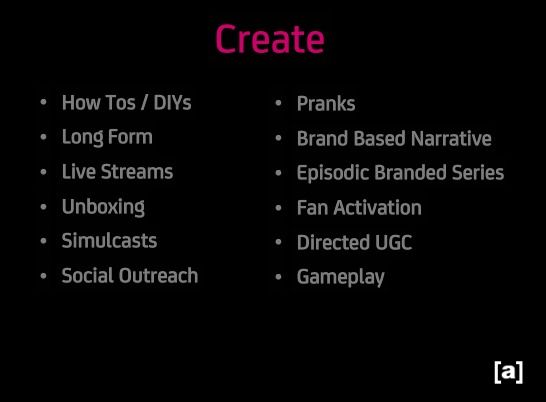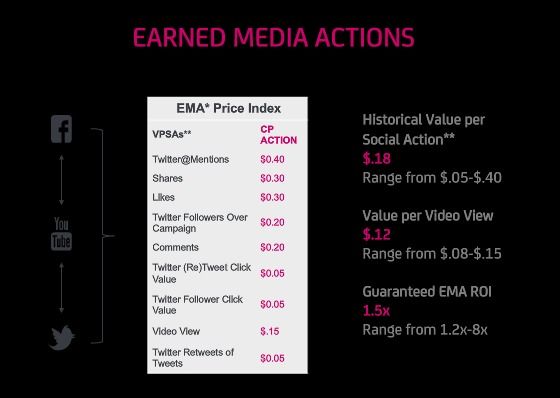Increasingly brand marketing is turning to influencers to communicate and reinforce brand messages. As social media has expanded, it has transformed the media landscape — and brand marketers have seen the possibilities inherent in this new way of reaching customers. When you see that top YouTubers can attract more than 30 million monthly viewers, that’s an audience worth reaching.
It’s more than just views, though. The role of influencers is deeper than merely showing someone a brand. Properly wielded, influencers are engaging and activating consumers in a way that few passive media impressions ever have. Effective influencer marketing means touching millions of consumers and turning some of them into brand evangelists as well, so the reach and impact can be substantial — and very cost-effective compared to classic marketing campaigns.

This is why Ayzenberg Group held a webinar today on Influence Marketing, bringing Vincent Juarez (principal and media director for Ayzenberg Group) and Chris Younger (principal and director of strategy for Ayzenberg Group) together to share some insights. It’s one thing to know that Influence Marketing is important; it’s quite another to know how to go about executing an influencer marketing campaign for best results.
For one thing, it’s important to recognize the wide variety of social media platforms where influencers wield their power. It’s not just about YouTube — it’s about Twitch, Vine, Pinterest, Twitter, Instagram, Tumblr, and a host of others. “New platforms are evolving with potential influencer activations,” noted Juarez, as he mentioned how platforms are even crossing over into each other.
It’s not easy to pick the right platform, though. “Different types of brands look to different platforms based on their interests,” said Younger. Matching the campaign to the correct platform requires consideration of the intended audience, the demographics, and the creative intent of the campaign. It’s a complex mix, to be sure.
One point that keeps coming up when marketers consider influence marketing is picking the right influencers. Should you try to work with the biggest influencers you can find that have the right audience, or are you better off lining up a number of influencers with smaller audiences “When you think about digital it’s an open landscape, anybody with any kind of interest can communicate,” Juarez said. “If you’re a fan of anything you can probably find an influencer to meet your needs. Everyone has the ability to be an influencer, whether it’s their own circle of friends or a larger group.”
When Ayzenberg Group works to create influencer campaigns, Younger likened it to baseball: You’re building a team and picking the right players for the right spots on the field, and that evolves as the game changes over time. “Discovery is a critical phase, to identify the key influencers is a mix of art and science,” Younger said. It’s a daunting task when you consider that there are over 400,000 influencers out there with a sizable audience, as Juarez noted. “Don’t ignore the obvious,” Juarez cautioned. “YouTube is the second largest search engine. Socialblade is also free. Dedicated platforms like Tubular aggregate 20 different content platforms.” These platforms can help you find influencers.

Juarez advocates a tiered approach, and using influencers from all tiers gets you the best results when it’s executed properly. “An army of lower-tiered influencers can be way more effective than an A-lister,” Juarez said. “Best practice is to use a combination of all tiers.” There’s also a budgetary consideration. “Tier 1 and Tier 2 influencers require substantial budget,” noted Juarez, because “they are approached by so many marketers they need financial incentive. Tier 3 and Tier 4 are more dedicated and will often participate based on their enthusiasm for the brand or product.”
In the end, Younger and Juarez agreed, influencers are human — and thus getting them to work with you is often a matter of negotiation and common interests, as well as their choice. While brand marketers are wary of going off-message with their brand, influencers are equally wary of losing their authenticity — and thus, their audience. That’s why the best results come when influencers are enthusiastic about a brand and a campaign, because that genuine emotion shines through.
“Once you’ve discovered the influencers you want to use, it’s time to figure out what to do with them. The second beat is Creativity,” Younger said. “What are we going to have them do. Is it just automatic. The key is providing a creative brief to influencers, based on listening to communities,” Younger explained.
At the end, the only way you’ll know how well an influencer campaign has performed is if you get the right data. “The last part is reporting and measurement,” Younger noted. “At the end of the day, like all other media vehicels, they have different roles and responsibilities. What kind of measurements can you use to say this is working ”
That’s a problem unless you get the right tools. “There are so many platforms, it’s about finding a partner that has a robust reporting toolset that allows you to aggregate all the metrics into one dashboard,” Juarez said. As for the key performance indicators, Juraez agreed that engagement is the most popular metric these days, but you really should try to do well on a variety of metrics.
Influencer marketing is indeed a combination of art and science, but with plenty of experience and talent, marketers can improve the effectiveness of influencer campaigns. Already, Juraez noted, he’s seen some campaigns have a remarkable return. “We’ve seen campaigns where the results have been eight-fold,” Juarez said. That’s something every marketer would love to achieve.

